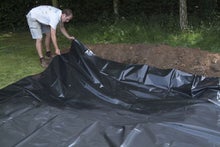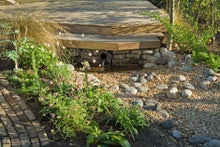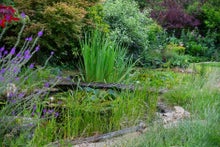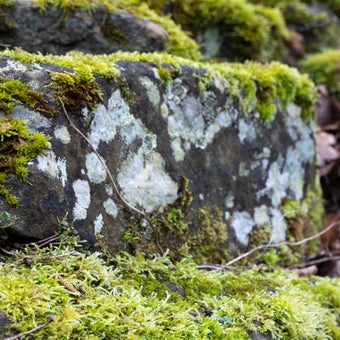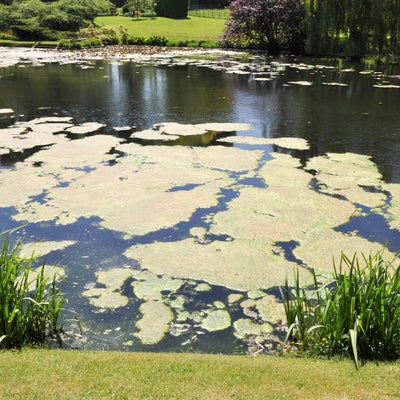
Quick facts
Hundreds of different types of algae can grow in ponds, and most garden ponds are likely to contain some
The most noticeable species tend to thrive in warm conditions and in water with high nutrient levels
Algae is a natural part of a pond ecosystem and can be good for wildlife
It is difficult and unnecessary to completely eradicate algae, but there are easy ways to stop it becoming a problem
What are pond algae?
Algae are simple, plant-like organisms. They can photosynthesise (harness the energy in sunlight) but don’t have true roots, stems or leaves.
Many different types of algae can grow in ponds and lakes. There are single-celled types that are suspended in the water and turn it green and others that are thread-like and spread across the surface in long fibres.
You might notice algae in your pond as:
- a ‘pea soup’ colour caused by fine algae suspended in water
- a floating green scum on the surface of the water or around the edges
- dense growths of hair-like green strands that float under or on the surface, or cling to plants at the side of the pond – these are known as blanket weed or silkweed
Apart from turning ponds green, algae can reduce oxygen levels in the water, which can be detrimental to pondlife and the healthy growth of ornamental pond plants. They are, however, a natural part of pond ecosystems and having some algae can provide valuable shelter for pond wildlife.
Whether or not you take action to control algae is a matter of choice – they often make a temporary appearance in the warmer months and may not need controlling. In large ponds, they can be difficult to tackle, and in wildlife ponds it is best to disturb the ecosystem as little as possible.
However, if you like to have clear water in your pond, you may wish to take steps to reduce or discourage algae.

The British Phycological Society is a charity committed to the study of algae. If you are interested in learning more about these fascinating organisms, their website includes lists of publications and information on how to become a member.
What causes the growth of algae in ponds?
Algae are good at travelling; they can be transported by animals (especially waterfowl) and their spores are carried long distances in the air. There may be many different types of algae in a pond that remain unnoticed until conditions favour their growth and they begin to thrive.
Most ponds will develop algae and blanket weed at some time or another, but they’re particularly common in ponds in a sunny position, with very little planting to provide shade across the surface.
Algae also form when pond water is especially rich in nutrients. There are a number of ways nutrient levels can build up in a pond; see the section below for information on how you can prevent this happening.
How to deter and remove algae
If your pond is covered in algae, it can be tempting to change the water – this may solve the immediate problem but will only make things worse in the long run. The best way to discourage algae long term is to remedy the conditions that are helping it to thrive.
Reduce nutrient levels
- Avoid putting soil in your pond. When adding new plants, make sure they are in low-nutrient, aquatic .
- Stop fertilising nearby lawns and borders. If feeding is essential for the health of surrounding plants, use the minimum effective dose to reduce the risk of excess leaching into the pond.
- Place a net over your pond in autumn to prevent leaves falling in.
- Use rainwater to top up your pond. If water levels drop too low in summer, it is better to add rainwater, whenever possible, rather than tap water, because nutrients in tap water encourage algae.
- Keep the pond free of fish, as their faeces add nutrients to the water. If you do want fish, choose goldfish, orfe or shubunkin. Keep populations in check by rehoming excess fish but never release them into the wild.
Other ways to discourage algae
- Add a fountain or cascade to the water. This can help prevent blue-green algae but is unlikely to have any effect on other types.
- Consider introducing ramshorn snails, which eat algae and decaying material. Avoid other water snails, which are less efficient scavengers, particularly those with long, pointed shells, as they tend to eat pond plants.
- Float a mesh bag of barley strawon the pond. Use about 50g of straw per sq m (1½oz per sq yd) of water surface; this should discourage all types of pond algae. Add the straw in spring and remove it when it has turned black (usually about six months later). Sometimes lavender is added to the barley straw for additional effectiveness.
- Add a pond dye. Dyofix Pond Black claims to help deter algal growth. By colouring the water black, it deflects ultraviolet rays, so the algae can’t photosynthesise. Surface plants such as waterlilies aren’t affected. It lasts for several months and can be used all year round. Pond Blue is paler, allowing you to see fish and other pondlife beneath the surface.
Various other products are available – some appear to be effective only in settling suspended debris, others may give short-term control of free-floating algae. Some claim to control the most troublesome types, such as filamentous algae or blanket weeds, but as there are many different forms of these, you might have to try several products to find one that works in your pond. Treatment needs to be repeated at intervals.
Remove algae
- Scoop out blanket weed and other floating algae using a net or rake, or use a to twirl them out.
- Install a pond filter or an ultraviolet clarifier to remove algae and other debris from the water.
- Hire a professional weed control company. This could be the best option if you have a large pond or lake. Use the National Association of Agricultural Contractors (select ‘find a contractor’, ‘amenity’ and 'aquatic weed control’) or Complete Weed Control to find those in your area.
- Consider using an ultrasound system in a large pond or lake. These have only recently been introduced and need professional installation. The ultrasound device is left permanently in the water and works by shaking apart algal cell walls, killing the algae within a few weeks. Different frequencies may work on different types of algae. For more details, go to Waterland Management.

Keep algae out of a new pond
If you’re making a new pond, take care to create the right conditions to deter pond algae from the beginning:
- Site the pond partly in light shade, not completely in full sun.
- Make it at least 60–75cm (2–2½ft) deep, if possible, to prevent the water warming up too rapidly in sunshine, which speeds up algal growth.
- Aim for about one-half of the pond surface to be covered by aquatic plants, while ensuring there are also sufficient submerged oxygenators. See our guide to choosing pond plants.
The colour of the pond liner is unlikely to make much difference when it comes to reducing algae. A pale liner might reduce temperatures, but would increase and thus algal growth, whereas a dark liner may decrease light reflection but increase water temperature, which is known to promote algae.
See our guides to making ponds:
Should I use a weedkiller?
No, there are no chemical treatments or weedkillers approved for use by home gardeners for the control of pond algae and blanket weed.




